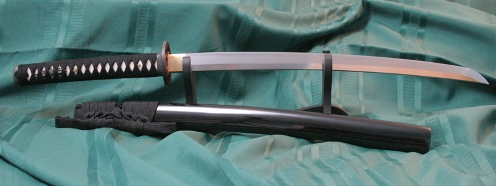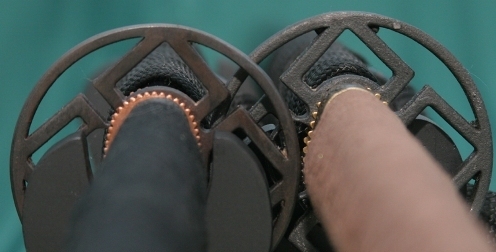Recent Articles
-
Real Katana Pushed to the limits
Mar 07, 25 01:16 AM
Cheness Kaze-Ko, the Little Katana
The Ko Katana, Japanese for little Katana, is a versatile Wakizashi sub variant. Mark Mowrey was one of the first people to buy the Kaze ko Katana from me soon after the sword was released as a companion to Cheness Cutleries most popular blade, the Differentially Hardened Kaze Katana.
Historically, these swords are commonly referred to as either O Wakizashi (great Wakizashi) Chisa Gatana (lit. Little Katana) or Kodachi (little sword) and were often used by the merchant classes as it did not violate the length restriction laws during the time of the Edo Shogunate, though it was also worn by the nobles at court and Samurai in place of a regular Wakizashi due to its shorter blade, which was of particular advantage when wielded in a tight space.
Indeed, there were even sword schools that specialized in the use of little Katana - drawing them faster than a regular Katana and overwhelming their surprised opponent with close fighting techniques and variations were even supposed to have been used by the historical Ninja!
Personally, these little Katana are actually one of my favorite types of Katana. They are amazingly fast and the short blade makes them as practical today as they were back in Fuedal Japan. But enough from me, I'll let Mark fill you in on the details of this traditionally forged and unique Katana design.
Cheness Kaze Ko Katana Review
Review by Mark Mowrey, Ohio, USA
|
Steel Weight Point of Balance Price Range |
9260 Spring Steel 2lbs 3.25" from tsuba US$229 |
I have been interested in a shortened, little katana for some time.
In the beginning of August 2007, Cheness announced the arrival of a new shipment including a few new models. One of those items was the Kaze Ko-Katana. It would be a perfect match to the full sized Kaze I already had. I was ready to place my order but prices were not yet available. I sent an email to Paul at SBG to see if he would be selling them. He assured me that SBG would be selling them and he would let me know when a price was available. I checked the Cheness website everyday for what seemed like forever until finally... a price. My order to the SBG Store was on its way.
As expected when ordering from the SBG Store, the newly released Cheness Kaze Ko-Katana arrived quickly and without incident. Customer service is top-notch from both Paul at SBG and Paul at Cheness. The box was kind of cute resting against my door. It was so small compared to the boxes my other swords have arrived in. My other ko-katana were sheathed in standard length saya requiring a full sized box. The display box is proportioned to the short 34" over all length.
Notice anything odd in this photo?

The instant I gripped Kaze Ko, I noticed that something felt different.
Notice anything odd in this photo?

It occurred to me after about 3 seconds... the menuki were at the palms of my hands, not the finger tips as I am used to. Hmmm... Feels kind of nice. I was wondering if this was an error on my tsuka or if all the Kaze Ko Katana were wrapped like this. I sent an email to Paul Chen at Cheness to find out from the source. I sent the following photo:

Here is Mr. Chen's response:
Hi Mark,
Thank you for your photos.
I had not noticed the spec change... but apparently, the Kaze Ko katana are all mounted with reverse of the gyaku menuki.
My standard had been the gyaku menuki ("reverse menuki" on the finger tip side) instead of the traditional mounting (in the palm side). The Kaze Ko Katana is a brand new item and apparently had been mounted with the traditional menuki (in the palm side).
My apologies for the error... I will change my description on my listings ASAP.... But as this is a batch-wide issue.... I am unable to replace your sword with a gyaku menuki mounted one.... at least not until the new batch arrives in 3 months or so. Please let me know what you would like to do.
Again, my apologies.
(FYI.... traditional location for the menuki is in the palm side. The menuki location moved to the fingertip side in later era for aesthetics reasons and became the standard for most iaido dojos today (this mounting is called gyaku menuki.... literally translated, it means "reverse menuki"). So, even though the reverse configuration is now the mainstream, but the traditional configuration actually has the menuki in the palm side).
Best Regards,
Paul Chen
Cheness Incorporated
As I previously stated, SBG and Cheness provide excellent customer service.
Ko-Katana Specifications
On occasion, my measurements differ from those listed by the manufacturer. I have included both for comparison.
- Cheness Inc. Specs
- Blade = Differentially Hardened 9260
- Nagasa = 21" Tip of kissaki to tsuba
- Sori = N/A
- Weight = 1 lbs. 12 oz.
- Tsuba/Fuchi/Kashira = Cast Iron
- POB = 2" from tsuba
- Tsuka/Ho = 10.5" Wood
- Tsuka/Ito = Black Cotton
- Mekugi = 1 bamboo plus 1 copper pin
- Same' = Real Ray Skin Panel Wrap
- Saya = 22" Black Glossy Lacquered Medium Hardwood
- My Specs
- Blade = Who am I to argue?
- Nagasa = I concur
- Sori = 0.5"
- Weight = 2 lbs. 1 oz.
- Tsuba/Fuchi/Kashira = I concur
- POB = 3.25" from tsuba
- Tsuka/Ho = 10.25"
- Tsuka/Ito = Black Cotton
- Mekugi = 1 bamboo plus 1 ridged pin that looks like brass to me
- Same' = I concur
- Saya = Black gloss finish
The Blade of the Kaze Ko has the same visible, natural hamon as its big brother. This is a result of the differentially clay hardening process that Cheness does with this 9260 blade that, according to Cheness, "closely resembles the behavior of a traditionally constructed blade."
In the right light, the hamon pops out. I think the polish on the Kaze Ko is a bit better than the Kaze I bought back in December 2006. There is a small flaw or scratch in the blade. It appears that this was done after polishing, poor handling perhaps. It looks like it was hit or rubbed with piece of metal. The marks are deep enough that I can actually feel them. Most of the other specks seen in the photo on the right are most likely dust from the paper towel I used to remove the protective grease from the blade. There are some other minor markings in the blade that the polishing failed to remove completely. I assume they are a result of the normal production process.


The curve of the blade is smooth and the kissaki appears to be nicely done. The polishing does not feel like it was done uniformly one each side of the blade though. When running a cloth down the blade, there seems to be a sight roll over on the edge. It's just enough to feel a little grab on the cloth here and there.


The tsuka is tightly wrapped with black cotton ito. The wrap is uniform but the cotton is a bit fuzzy. It probably just needs some sweat and oil from my hands worked into it. The tsuka is held to the nakago by two mekugi.

Removing the pin
The Brass Pin is a great safety measure, but it can be hard to dislodge. The trick is to use a short, sharp strike rather than tapping away.
Cheness states that the new Kaze series has an upgraded tsuka. One of the upgrades is that "one of the two bamboo mekugi pins has been replaced with a copper pin as an added safety measure." The pin looks a bit more like brass than copper to me. I have not removed the tsuka because I am a little leary of removing the metal pin. Ok, I know this metal pin is a major concern for some people. I have just tried to remove the pin. I used a steel punch and a hard rubber mallet. After a few, very hard hits the pin had not seemed to move enough for me to feel successful. Rather than force it, I decided to stop. Maybe this is another reasoning for the use of the metal pin; to keep non-professional people, such as myself, from removing, and possibly damaging the tsuka.

The new finish on the tsuba looks nice. Some of the inside corners still have some scaling or corrosion on them though. They may have just been missed in the process. I scraped at it some with a dental pick and it is pretty tough to get off.

The Cheness Kaze Ko-Katana feels very solid in my untrained hands. There is one flaw in the fit though. The tsuba is a tiny bit loose... Bummer... If I decide to remove the tsuka, I will try to add a shim to tighten things up. It won't take much.
The Kaze Ko fits very well in the saya. I prefer to have a snug fit and not have the katana fall out if turned upside down. I feel this is safer since my katana are mainly for display. One thing I noticed is that the koiguchi (saya opening) is not lacquered like the saya of my older Kaze. I do not know if this makes any difference though.
VIDEO: Cutting Tests
Cutting Tests on Paper, Leather, a variety of water filled targets (and the stand!)
Yeah, it cuts.
If you are looking for a little katana, what are you waiting for? Buy the Kaze Ko-Katana.
PROS
- Very agile blade
- Attractive and traditional authentic Hamon
- Excellent cutting ability
CONS
- Minor cosmetic defects on the blade and fittings
- May require minor adjustments out of the box
WHERE TO BUY This Little Katana...
Mark bought his Kaze Katana here from SBG Sword Store for $229.99. Even after all these years, these little Katana are still very popular and going strong, and the best part - the price hasn't changed either.
I hope this review and information on the little Katana by Cheness Cutlery has been helpful. To return to A Beginners Guide to Authentic Japanese Swords from Cheness Kaze Ko, the Little Katana , click here














